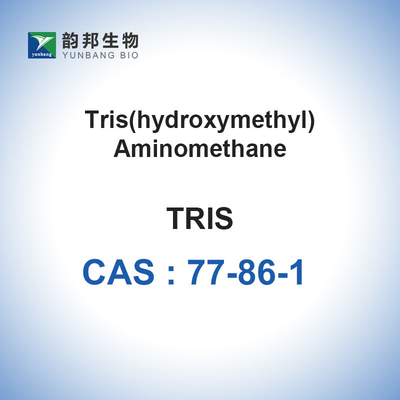Tris Base 77-86-1 Biological Buffer Trometamol
| CAS: |
77-86-1 |
| MF: |
C4H11NO3 |
| MW: |
121.14 |
| EINECS: |
201-064-4 |
| Melting point |
167-172 °C(lit.) |
| Boiling point |
219-220 °C10 mm Hg(lit.) |
| density |
1,353 g/cm3 |
| vapor pressure |
0.0267 hPa (20 °C) |
| refractive index |
1.4170 (estimate) |
| Fp |
219-220°C/10mm |
| storage temp. |
20-25°C |
| solubility |
H2O: 4 M at 20 °C, clear, colorless |
| form |
crystalline |
| color |
white |
| PH |
10.5-12.0(4 m in water, 25 °C) |
| pka |
8.1(at 25℃) |
| PH Range |
7 - 9 |
| Water Solubility |
550 g/L (25 ºC) |
| Sensitive |
Hygroscopic |
| λmax |
λ: 260 nm Amax: 0.10
λ: 280 nm Amax: 0.08 |
| Merck |
14,9772 |
| BRN |
741883 |
| Stability: |
Stable. Incompatible with bases, strong oxidizing agents. Protect from moisture. |
| InChIKey |
LENZDBCJOHFCAS-UHFFFAOYSA-N |
| CAS DataBase Reference |
77-86-1(CAS DataBase Reference) |
| NIST Chemistry Reference |
1,3-Propanediol, 2-amino-2-(hydroxymethyl)-(77-86-1) |
| EPA Substance Registry System |
Tris(hydroxymethyl)aminomethane (77-86-1) |
Uses of Tris Buffer in Protein Electrophoresis and Western Blotting
Tris buffers are integral to protein electrophoresis and western blotting. Most SDS-PAGE gels, running buffers, and blotting buffers are buffered with Tris. All the common buffers are available premixed, or, if you prefer to make your own Tris buffer, you can start with purified Tris powder, glycine, and other molecular biology grade buffer reagents.
Most SDS gels use a discontinuous Tris buffer system. The stacking gel, which has large pores so that larger peptides can easily migrate through, is usually formulated at pH 6.7–6.8. At this pH, ionized chloride ions migrate rapidly, raising the pH behind them and creating a voltage gradient with a zone of low conductivity, which causes glycine (from the running buffer) to ionize and migrate behind the chloride front. Most peptides in the sample, which have a negative charge due to the bound SDS, migrate between the chloride and glycine, forming a narrow band and thus becoming "stacked".
Once the stack reaches the resolving gel, which is at a higher pH (typically pH 8.7–8.8), the increased ionization of the glycine causes it to accelerate and overtake the peptides. Additionally, the smaller pore size of the resolving gel starts to have a sieving effect, resulting in the separation of peptides by size.
Most western blotting protocols use a Tris buffer of low ionic strength for protein transfer. The transfer time depends on the type of blotting apparatus and the peptide size range of interest.
Use of Tris Buffer in Nucleic Acid Agarose Electrophoresis
Tris buffers are widely used for DNA agarose electrophoresis. The two main buffers are TBE (Tris borate/EDTA) and TAE (Tris acetate/EDTA). Although there are some differences in the resolution of different forms of DNA and their mobility during electrophoresis, these Tris buffers can generally be used interchangeably. The borate ions in TBE inhibit many enzymes, so without performing some type of DNA purification after electrophoresis, some enzyme-mediated downstream manipulations may not work. Therefore, TAE buffer is favored for everyday use in most DNA labs.
Making a Tris Buffer
Tris buffer is a good choice for most biological systems because it has a pKa of approximately 8.1 at 25°C, making it an effective buffer in the range of pH 7–9. This pH range is suitable for the majority of biological processes. Tris powder is also less expensive and more robust than more specialized buffers such as HEPES.
There are two ways to make a Tris buffer solution. One is to make solutions of Tris base and Tris HCl, both at the desired concentration, and then add aliquots of one solution (usually Tris HCl) to the other (usually Tris base) solution while monitoring the pH until the correct pH is obtained. In practice, this is very rarely done.
The usual method of making most of the commonly used Tris buffers is to start with only Tris base. The appropriate amount of Tris powder is dissolved in water, the pH is adjusted with HCl, and then the buffer is made up to the desired volume. Assuming that there is no overshoot while adjusting pH, this method does not change the ionic strength. However, after overshoot and readjusting with NaOH, or using Tris HCl and adjusting the pH with NaOH, there is a change in ionic strength. Depending on the intended use of the Tris buffer, such a change may or may not be important.
When making a Tris buffer, it is important to use a Tris-compatible electrode when adjusting the pH. Single-junction Ag/AgCl electrodes can exhibit instability when used with Tris buffers because the silver gradually precipitates and clogs the electrode. The use of double-junction or calomel reference electrodes ensures accurate pH measurements in Tris buffer.

 Your message must be between 20-3,000 characters!
Your message must be between 20-3,000 characters! Please check your E-mail!
Please check your E-mail!  Your message must be between 20-3,000 characters!
Your message must be between 20-3,000 characters! Please check your E-mail!
Please check your E-mail! 






